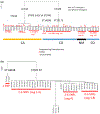Multistate population and whole genome sequence-based strain surveillance of invasive pneumococci recovered in the USA during 2017
- PMID: 31536818
- PMCID: PMC12019393
- DOI: 10.1016/j.cmi.2019.09.008
Multistate population and whole genome sequence-based strain surveillance of invasive pneumococci recovered in the USA during 2017
Abstract
Objectives: We aimed to provide population-based and whole-genome sequence (WGS) -based characterization of invasive pneumococcal disease isolates collected from multistate surveillance in the USA during 2017.
Methods: We obtained short-read WGS from 2881 isolates with associated bioinformatics pipeline strain feature predictions. For quality control, capsular serotypes and antimicrobial MICs were also obtained conventionally from 442 isolates. Annotated WGS were provided (inclusive of serotypes, MICs, multilocus sequence types, pilus type(s)) from 2723 isolates. For 158 isolates with suboptimal WGS, antimicrobial MICs were obtained conventionally.
Results: There were 127 isolates from children <5 years of age and 2754 isolates from those ≥5 years old in 2017. One of 43 different serotypes was predicted for 2877 of the 2881 isolates. Serotypes in the 13-valent conjugate vaccine together with 6C (PCV13+6C) accounted for 816 (28.3%) isolates, with PCV13 serotype 3 being the most common serotype overall. Non-PCV13-6C- serotypes accounted for 2065 (71.7%) isolates, comprising 96 (75.6%) isolates from children < 5 years old and 1969 (61.4%) isolates from those aged ≥5 years. Of 36 different categories of recently emerged serotype-switch variants, three showed marked increases relative to 2015-2016 in that the number from 2017 surpassed the number from 2015-2016 combined. Two of these included antimicrobial-resistant serotype 11A and 35B serotype-switch variants of the ST156 clonal complex.
Conclusions: PCV13+6C strains are still identified in 2017 but non-PCV13-type strains impose a considerable burden. This well-annotated year 2017 WGS/strain data set will prove useful for a broad variety of analyses and improved our understanding of invasive pneumococcal disease-causing strains in the post-PCV13 era.
Keywords: Capsular serotypes; Clonal complexes; Invasive pneumococcal disease incidence; Resistance features; Serotype switch variants.
Published by Elsevier Ltd.
Conflict of interest statement
Transparency declaration
The authors are aware of no relationships/conditions/circumstances that present a potential conflict of interest. The findings and conclusions in this report are those of the authors and do not necessarily represent the official position of the CDC. All authors report no conflicts of interest relevant to this article.
Figures





References
-
- Pilishvili T, Lexau C, Farley MM, Hadler J, Harrison LH, Bennett NM, et al. Sustained reductions in invasive pneumococcal disease in the era of conjugate vaccine. J Infect Dis 2010;201:32–41. - PubMed
-
- Moore MR, Link-Gelles R, Schaffner W, Lynfield R, Lexau C, Bennett NM, et al. Effect of use of 13-valent pneumococcal conjugate vaccine in children on invasive pneumococcal disease in children and adults in the USA: analysis of multisite, population-based surveillance. Lancet Infect Dis 2015;15:301–9. - PMC - PubMed
MeSH terms
Substances
Grants and funding
LinkOut - more resources
Full Text Sources
Medical

